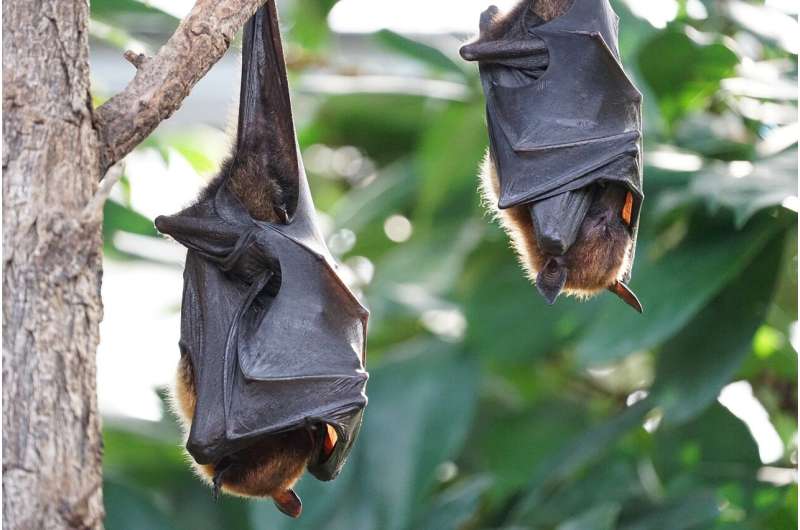This article has been reviewed according to Science X's editorial process and policies. Editors have highlighted the following attributes while ensuring the content's credibility:
fact-checked
peer-reviewed publication
trusted source
written by researcher(s)
proofread
Math makes finding bat roosts much easier, our research shows

Finding bats is hard. They are small, fast and they primarily fly at night.
But our new research could improve the way conservationists find bat roosts. We've developed a new algorithm that significantly reduces the area that needs to be searched, which could save time and cut labor cost.
Of course, you may wonder why we would want to find bats in the first place. But these flying mammals are natural pest controllers and pollinators, and they help disperse seeds. So they are extremely useful in contributing to the health of our environment.
Despite their importance though, bat habitats are threatened by human activities such as increased lighting, noise and land use. To ensure that we can study and enhance the health of our bat population, we need to locate their roosts. But finding bat roosts is a bit like finding a needle in a haystack.
Our previous work measured and modeled the motion of greater horseshoe bats in flight. Having such a model means we can predict where bats will be, depending on their roost position. But the position of the roost is something we often don't know.
Our new research combines our previous mathematical model of bat motion with data gathered from acoustic recorders known as "bat detectors." These bat detectors are placed around the environment and left there for several nights.
Seeing with sound
Bats use echolocation, which allows them to "see with sound" when they're flying. If these ultrasonic calls are made within ten to 15 meters of a bat detector, the device is triggered to make a recording, providing an accurate record of where and when a bat was present.
The sound recordings also provide clues about the identity of the species. Greater horseshoe bats make a very distinctive "warbling" call at almost exactly 82kHz in frequency, so we can easily tell whether the species is present or not.
Assuming that a bat detector's batteries last for a few nights, its memory card is not full, and the units are not stolen or vandalized, then we can use the bat call data to generate a map that shows the proportion of bat calls at each detector location.
Our model can also be used to predict the proportion of bat calls based on a given roost location. So, we split the environment up into a grid and simulate bats flying from each grid square. The grid square, or squares, whose simulations best reproduce the bat detector data will then be the most likely locations of the roost.
This simple algorithm can then be applied to whole terrains, meaning that we can create a map of likely roost locations. Cutting out the regions that are least likely to contain the roost can mean we shrink the search space to less than 1% of the initially surveyed area. Simplifying the process of finding bat roosts allows more of an ecologist's time to be spent on conservation projects, rather than laborious searching.
In 2022, we developed an app that uses publicly available data to predict bat flight lines. At the moment the app can help ecologists, developers or local authority planners, know how the environment is used by bats. However, it needs a roost location to be specified first, and this information is not always known. Our new research removes this barrier, making the app easier to use.
Our work offers a way of identifying likely roost locations. These estimates can then be verified either by directly observing particular features, or by capturing bats at a nearby location and following them back home, using radiotracking.
Over the past two decades, bat detectors have gone from simple hand-held machines to high-performance devices that can collect data for days at a time. Yet they are usually deployed only to identify bat species. We have shown they can be used to identify the areas most likely to contain bat roosts, uncovering critical information about these most secretive of animals.
We hope that this will provide further tools for ecologists to optimize the initial microphone detector locations, thereby providing a holistic way of detecting bat roosts.
More information: Lucy Henley et al, A simple and fast method for estimating bat roost locations, Royal Society Open Science (2024). DOI: 10.1098/rsos.231999
Journal information: Royal Society Open Science
Provided by The Conversation
This article is republished from The Conversation under a Creative Commons license. Read the original article.![]()





















